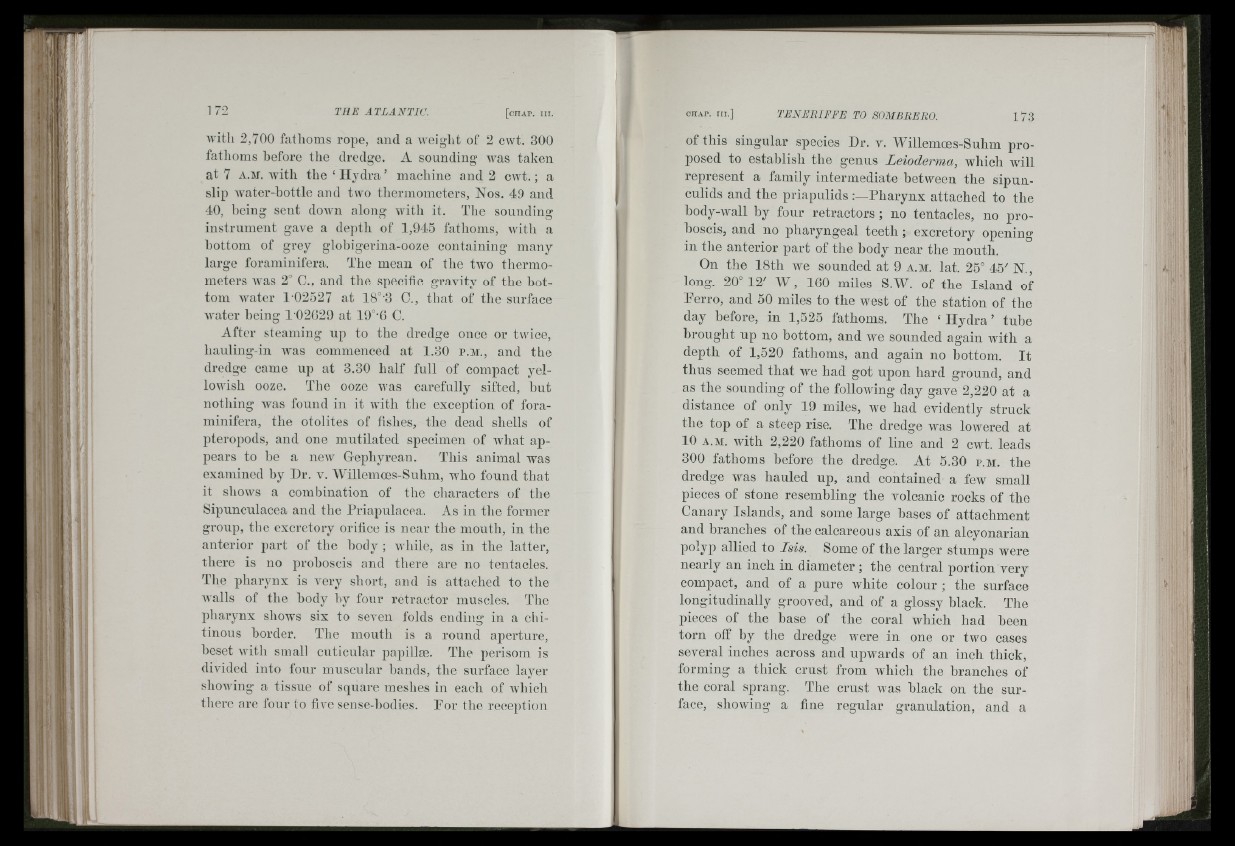
P:-,--: A ■
i i w f •
)
t I 1
pR -ist
172 T H E A T L A N T I C . [ c i iA r . III.
with 2,700 fathoms rope, and a weight of 2 cwt. 300
fathoms before the dredge. A sounding was taken
at 7 A .M . witli tbe ‘ Hydra ’ machine and 2 cwt.; a
slip water-bottle and two thermometers. Nos. 19 and
10, being sent down along with it. Tbe sounding
instrument gave a deptli of 1,915 fathoms, with a
bottom of grey globigerina-ooze containing many
large foraminifera. The mean of the two thermometers
Avas 2° C., and the specific gravity of the bottom
water 1-02527 at 18°-3 C., tbat of tlie surface
Avater being 1-02029 at 19°-G C.
After steaming up to the dredge once or twice,
bauling-in was commenced at 1.30 p.m., and the
dredge came up at 3.30 balf full of compact yellowish
ooze. Tbe ooze a a u s carefully sifted, but
nothing AA'as found in it AA'ith the exception of foraminifera,
the otolites of fishes, tbe dead shells of
pteropods, and one mutilated specimen of Avliat appears
to be a ucAV Gepliyrean. This animal was
examined by Hr. v. Willemoes-Sulim, Avho found tbat
it sboAvs a combination of the cliaracters of the
Sipunculacea and tbe Priapulacea. As in tbe former
group, the excretory orifice is near the mouth, in the
anterior jiart of the body ; aa bile, as in the latter,
there is no proboscis and there are no tentacles.
The pharynx is very sbort, and is attached to the
Avails of tbe body by four retractor muscles. The
pharynx s I io a v s six to seven folds ending in a chi-
tinous bordeiL The mouth is a round aperture,
beset Avitli small cuticular papillae. The perisom is
divided into four muscular bands, the surface layer
sboAving a tissue of square meshes in each of Avbich
there are four to five sense-bodies. Por tlie reception
CHAP. i n . ] T E N E R I F F E T O S O M B R E R O . 173
of this singular species Dr. v. Willemoes-Suhm proposed
to establish the genus Leioderma, which will
represent a family intermediate between the sipuu-
culids and the priapulids Pharynx attached to the
body-Avall by four retractors ; no tentacles, no proboscis,
and no pliaryngeal teeth ;= excretory opening
in the anterior part of the body near the mouth.
On the 18th we sounded at 9 a .m . lat. 25° 45' N.,
long. 20° 12' W , 160 miles S.W. of the Island of
Eerro, and 50 miles to the west of the station of the
day before, in 1,525 fathoms. The ‘ Hydra’ tube
brought up no bottom, and we sounded again with a
depth of 1,520 fathoms, and again no bottom. It
thus seemed tbat Ave had got upon hard ground, and
as the sounding of the folloAviug day gave 2,220 at a
distance of only 19 miles, we had evidently struck
the top of a steep rise. The dredge Avas lowered at
10 A.M. AAdth 2,220 fatlioms of line and 2 cwt. leads
At 5.30 P.M. the
and contained a few small
pieces of stone resembling the volcanic rocks of the
Canary Islands, and some large bases of attaclimeut
and brandies of the calcareous axis of an alcyonarian
polyp allied to Isis. Some of the larger stumps were
nearly an inch in diameter ; the central portion very
compact, and of a pure Avhite colour ; the surface
longitudinally grooved, and of a glossy black. The
pieces of the base of the coral which had been
torn off by tiie dredge were in one or two cases
several inches across and upw'ards of an inch thick,
forming a thick crust from Avhich the branches of
the coral sprang. The crust Avas hlack on the surgranulation,
and a
300 fathoms before the dredge,
dredge Avas hauled up
r"
r
I;
face, showing a fine regular
"Ait